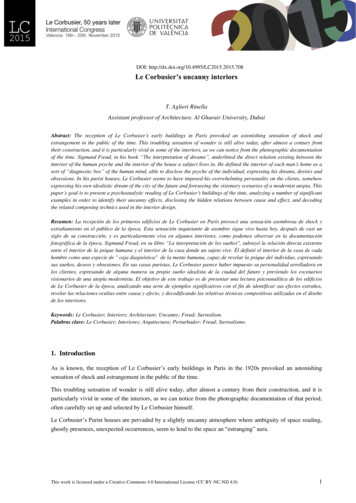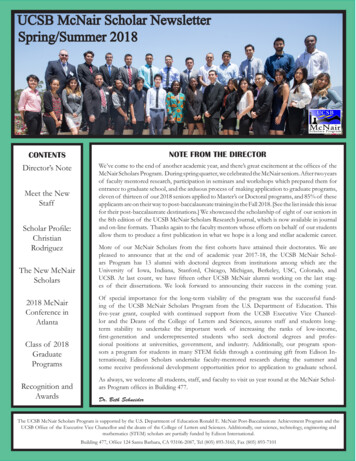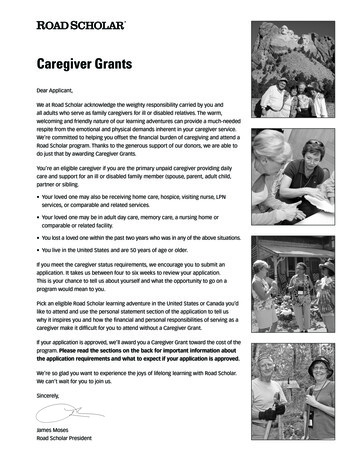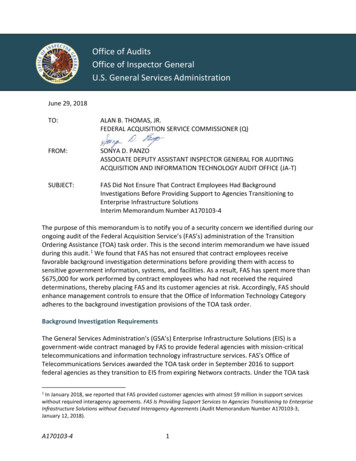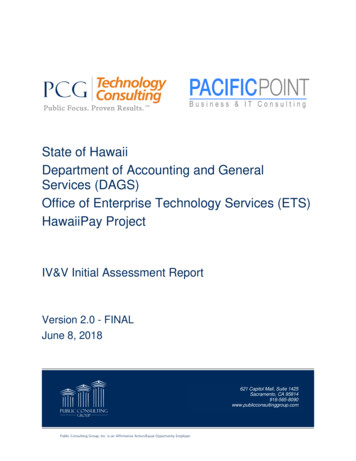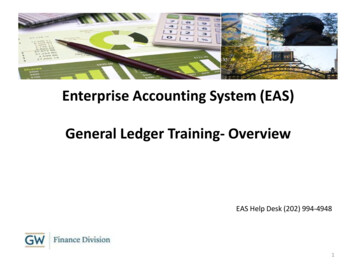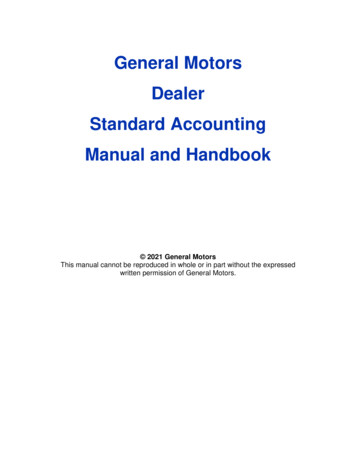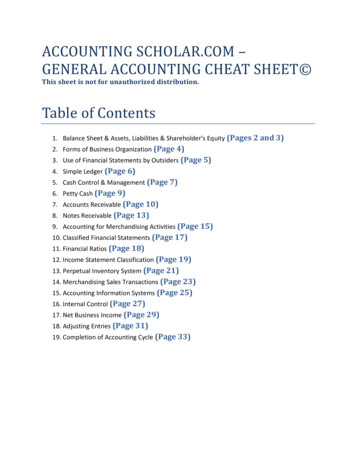
Transcription
ACCOUNTING SCHOLAR.COM –GENERAL ACCOUNTING CHEAT SHEET This sheet is not for unauthorized distribution.Table of Contents1. Balance Sheet & Assets, Liabilities & Shareholder’s Equity (Pages 2 and 3)2. Forms of Business Organization (Page 4)3. Use of Financial Statements by Outsiders (Page 5)4. Simple Ledger (Page 6)5. Cash Control & Management (Page 7)6. Petty Cash (Page 9)7. Accounts Receivable (Page 10)8. Notes Receivable (Page 13)9. Accounting for Merchandising Activities (Page 15)10. Classified Financial Statements (Page 17)11. Financial Ratios (Page 18)12. Income Statement Classification (Page 19)13. Perpetual Inventory System (Page 21)14. Merchandising Sales Transactions (Page 23)15. Accounting Information Systems (Page 25)16. Internal Control (Page 27)17. Net Business Income (Page 29)18. Adjusting Entries (Page 31)19. Completion of Accounting Cycle (Page 33)
The Balance Sheet Used to show the financial position of a business entity on a specific date.They are always prepared at the end of the year and often more often.A balance sheet lists the businesses' assets, liabilities and owner's equity.The balance sheet is dated because the financial position can change quickly.Features:HeadingThree Sections: assets, liabilities and owner's equity.Business Entity - business finances must be kept separate from personal affairs of the owner.Assets Assets are economic resources that are owned by a business and are expected tobenefit future operations.Examples: buildings, machinery, accounts receivable.Valued at cost value. that is what you paid for the asset, not what it is worth today.Generally Accepted Accounting Principles (GAAP)Cost PrincipleValued at cost value. that is what you paid for the asset, not what it is worth today.Going-Concern Assumption (assets are acquired for use not resale) Objectivity PrincipleObjective - factual and can be verified by others.Stable Dollar Assumption - even though inflation may have changed value of old dollars,they are thought of as new dollars.
Liabilities Debts of a businessAll businesses have debts. It is convenient to buy with creditThe purchase of goods of services for credit is an account payableWhen money is borrowed it is a note payableOwner's Equity Represents the resources invested by the owner Residual claim because claims of creditors come first Equal to the total assets minus the total liabilities Increase in Owner's Equity comes from 1) Investment and 2) Earnings Decreases come from 1) Withdrawals and 2) LossesThe Accounting EquationAssets Liabilities Owner's Equity Always One side shows what a business owns and the other side shows who supplied theseresources. All assets have been supplied by creditors or the owner
Forms of Business OrganizationSole Proprietorship A business owned by one person.The most common form of ownership in our economy.E.g stores, farms, service businesses.From an accounting viewpoint, it is a business entity separate from the affairs of the owner.From a legal standpoint, they are not separate entities and the owner is personally liable forthe debts of a business.If the business fails, creditors may force the owner to sell personal assets to pay off debts.Partnerships an unincorporated business owned by two or more persons. not legally an entity separate from its owners (owners are personally responsible for debtsof the business). accounting practices sees the business as separate from personal affairs.Corporations the only type of business recognized legally as separate from its owners (owners are notpersonally responsible for debts). limited liability - you can only lose what you have invested in the business. owners are shareholders and hold transferable shares of capital stock (the stock can besold). most large businesses are organized as corporations.Reporting Ownership Equity in the Balance SheetSole Proprietorship - the equity section contains only the equity of the proprietor.Partnership - Partner's Equity is used instead of Owner's Equity and the amount of each partner'sequity is listed separately.Corporation - use the title Shareholders EquityShareholders equity is divided into capital stock (amount originally invested in the business) andretained earnings (the amount of increase in shareholder's equity that has resulted fromprofitable business transactions).
The Use of Financial Statements byOutsiders financial statements are used outside of the business to make investment decisions.creditors and investors are concerned with the solvency and profitability of thebusiness.Solvency - the ability of a business to pay debts when they come due. If a business can meet itsobligations it is called solvent. If a business cannot pay debts, it is insolvent and may facebankruptcy. A bankrupt business may have to stop operations, sell its assets to pay creditorsand end its existence.Profitability - a business is profitable when revenue exceeds expenses for an accountingperiod. This increases the value of the owner's equity.
The Simple LedgerAccount - A form in which changes caused by transactions are recorded. There is one account for each item affecting the financial position (each asset,liability, and owner's equity)Ledger - All of the accounts together also called a group of accounts the data from the balance sheet is used to set up the accounts. the dollar figure for the account is written on the first line. This is the beginning value of theaccount. the dollar figure must be recorded on the side that the account appears in the balancesheet.Debit/CreditDebit refers to the left side of any account. Credit refers to the right sideof any account.Any AccountDebitCredit1. The normal balance of any account goes on the same side that it appears on the balancesheet i.e (Asset - Left)2. Increase on the balance side.3. Decrease on the side opposite the balance.Analyzing Transactions1. What accounts?2. Classification3. Increase/ Decrease4. Debit/Credit5. How much?
Cash Control & Management cash is money on deposit or any items that a bank will accept for deposit. Thecash account is a controlling account for perhaps many bank accounts.Cash on the balance sheet listed first because it is available to meet obligations. it is the most liquid asset, assets are listed in order of liquidity. some short term investments are so liquid that they are combined with cash on thebalance sheet. creditors are interested in how cash compares with accounts payable. Is thecompany able to pay debts as they become due? This is called solvency.Statement of Changes in Financial Position this statement summarizes all of the cash activity during the accounting period.Cash Management planning, controlling, and accounting for cash transactions and cash balances. the objectives of cash management include:1. provide accurate accounting for cash receipts, cash disbursements, and cash balances.2. prevent losses from theft or fraud.3. anticipate the need for borrowing and make sure there is enough cash to conductbusiness operations.4. make sure large amounts of cash are not left idle but instead are generating revenue.Internal Control of Cash Those who handle cash should not have access to accounting records. These jobs shouldbe separate. A cash budget with planned cash receipts, cash payments and cash balancesshould be prepared for each department. A control listing should be prepared for all cash receipts at the time and place money isreceived. All cash receipts should be deposited daily. All payments should be made by cheque. All expenditures should be verified before the cheque is issued. These jobs should beseparate. Bank statements should be reconciled.Cash ReceiptsA/R received through mail. cheques should be stamped "For deposit only." they should be recorded on a control listing.Cash received over the counter.
all cash received is recorded on the cash register. Tape keeps track of alltransactions. Someone from accounting will remove the tape.the cash register could be a point-of-sale terminal connected to accounting records.Cash Over and Short in handling cash, mistakes are made when giving change. the difference between recorded cash receipts and the money in the cash registerare recorded in an account called "Cash Over and Short." debit for a shortage/ credit for an overage.Cash Disbursements all disbursements should be made by prenumbered cheques. Signing cheques,approving payment and making accounting entries should be different jobs.The Voucher System every transaction that results in a cash payment must be verified, approved inwriting, and recorded before a cheque is issued. a written authorization called a voucher is prepared for every transaction that willrequire a cash payment.Preparation1. The appropriate blanks are filled in with information from the invoice (name, number,date, amount).2. The Voucher is sent to an employee who verifies information3. The voucher is then sent to employee in accounting who indicates the credit and debit4. All verification is checked5. The voucher is then entered in the Voucher Register
Petty Cash it is important to made large cash payments by chequesometimes a business needs to have a small amount of cash to pay smallexpenditures when cheques are not practicable ( birthday cakes, officesupplies,etc)Creating the petty cash funds a cheques is written payable to petty cash/ it is cashed/ the money is kept onhand in a locked box.Petty CashCash 100100As petty cash is used, petty cash vouchers are prepared.petty cash voucher: date, amount paid, purpose, signiturethe box should always contain cash and vouchers totalling the amount of thefund.Replenishing when the cash is low, a new cheque is drawn and the expenses are recorded.Office Supplies ExpenseEntertainment ExpenseCash 256085-Petty cash is only debited when first established; there are usually no furtherentries to the account.
Accounts Receivable selling goods or services on credit is important to business.however, businesses realize that when sales are made on account, some of theseaccounts receivable will be uncollectible.once an A/R is determined to be uncollectible, it is no longer an asset.the loss of an asset is an expense (uncollectible accounts expense).accounting principles require that in measuring income, revenue should be matchedwith the expenses incurred in raising the revenue.because the A/R may not become uncollectible until sometime later, the uncollectiblesmust be estimated and then matched.Uncollectible Accounts Expense5000.00Allowance for Doubtful accounts5000.00 Allowance for Doubtful Accounts will appear on the balance sheet as a deductionfrom A/R.Accounts ReceivableAllowance for doubtful accountsFinal A/R Amount 70,000Allowance for Doubtful Accounts Assetsthere is no way of telling which A/R will turn out to be uncollectible.crediting the controlling account for A/R would throw the individual accounts outof balance with the controlling account.therefore, Allowance for Doubtful Accounts is credited.it is a contra asset account.it must be estimated in a conservative manner.the account must be adjusted monthly.Writing Off an Uncollectible A/Rwhen an A/R from a specific customer is determined to be uncollectible it is no longeran asset and should be written off.Allowance for Doubtful AccountsAccounts Receivable (JJ Jackson) Balance Sheet75,00005,000700.00700.00this is not a debit to an expense because the expense has already been estimated.write-offs will seldom agree with estimates.if an A/R previously written off is recovered, then the opposite entry is made.
Accounts Receivable (JJ Jackson)Allowance for Doubtful AccountsMonthly Estimates of Credit Loss At the end of each month, uncollectible accounts should be estimated and anadjustment should be made to Allowance for Doubtful Accounts.If some accounts have been written off and the balance is the allowance account hsouldbe higher, then an entry to increase the balance must be madeEstimate for Credit Loss are base on:1. The balance sheet approach based on aging schedule.2. The income statement approach based on a percentage of net credit sales3. Direct Write-off methodMonthly Estimates - Credit Losses At the end of each month, credit losses should be estimated and Allowance for Doubtfulaccounts adjusted.Balance Sheet for Aging Method Most widely used Each A/R is classified according to its ageAging ScheduleJacksonMachine Co.XYX Co.ABC CoSpadeWholesaleRichmondSupplyBuggy storesTotalsTotalNot yetDue1-30 Dayspast 1000003200051000220002900031-60 dayspast due61-90 dayspast dueOver 90days pastdue6001000240030004000500024000960012000The schedule is used to review that status of individual accounts and as the basis of estimatesof uncollectible accountsThe longer an account is past due, the greater the chances it won't be collected.
Based on experience, the credit manager will estimate the percentage of credit losses likely tooccur in each age group.Age Group TotalPercentageNot Yet Due1-30 days past31-60 days past61-90 days pastOver 90 days ounts510870120060025005680Income Statement Method focuses on estimating the uncollectible accounts expense for the period. an estimate is based on percentage of net credit sales. fast and simple: used by smaller businesses.
Notes Receivable promissory note: promise to pay on demand on or before a future date, a definite sumof money. Maker: person who promises to pay - borrower of the money (L) Payee: person to whom payment is to be made - lender of the money s (A) Interest Charge made for the use of money Interest Principle * Rate * Time Rate (interest rate annual) rate is on an annual basis time is in days, months or annual 3 days grace from when due (use this to calculate exact days)When initially lending money: Note to payA/R:Dec INotes Receivable30000.00A/R30000.00 90days 12%Adjust for interest earned at end of year: Dec 31Interest Receivable295.89Interest Revenue295.89 30,000* 12% * 30/365When paid:March 4Cash30917.26Notes Receivable30,000Interest Receivable295.89Interest Revenue621.3730,000 * 12% * 93/365Accounts Receivable TurnOver Rate indicates how quickly a company converts its accounts receivable into cash. The Accounts Receivable turnover rate is determined by dividing net salesby the average of accounts receivable. The number of days required to collect accounts receivable then may bedetermined by dividing the number of days in a year (365) by the turnover rate.Net Sales / Avg of Accounts Receivable50,000 / 11000 4.455Average of accounts receivable: Start (10,000) End (12,000) 22,000 / 2 11,000 Forinstance: 365 / 4.455 about 81
the interpretation of the average age of receivables depends upon the company's creditterms and the seasonal activity immediately before year-end.Basic FormulaNet Credit SalesMonthly Average Receivables365 Turnover Rate Days required to collectTurn over rateAverage Receivable (Beginning Ending ) / 2
Accounting for Merchandising Activities Merchandising companies earn revenue by selling goods.The goods being sold are called Inventory.Inventory is a very liquid asset that usually appears near the top of the balance sheet.Operating Cycle - Merchandising Companypurchase merchandisesale of merchandiseIOperating CycleICollection of Accounts ReceivableIncome Statement of a Merchandising Company a major cost to merchandising businesses is the cost of the goods it buys to resell(cost of goods sold). this is an expense that is shown separately on the income statement.Sales- Cost of goods sold Gross Profit on SalesGross Profits on Sales E- Expenses Net IncomeA merchandising company needs more information.Accounts receivable in accounting statements is the total accounts receivable. The companyneeds to know the accounts receivable for each customer. The detailed information isfound in a subsidiary ledger.Subsidiary Ledger: shows the individual items that comprise the balance of a general ledgeraccount.example: Accounts Receivable Leger contains a separate account for each customer. the general ledger account that summarizes the content of the subsidiary ledger iscalled a controlling account.Merchandising Transactions require: Accounts Receivable Ledger Accounts Payable Ledger Inventory Ledger
Posting any entry that affects a subsidiary ledger also effects the controlling account andmust be posted twice. post first to the sub ledger and then to the controlling account. a check mark shows it is posted to sub journal.
Classified Financial StatementsClassified Balance SheetAssets are presented in three groups:1. Current Assets "liquid" capable of being turned into cash within a short period of time (one year) examples are:cash, inventory, accounts receivable.2. Plant and Equipment fixed assets examples: land, building3. Other assetsLiabilities are grouped into two categories:1. Current liabilities existing debts that must be paid within the same time period as current assets. examples: notes payable, accounts payable.2. Long term liabilities example: mortgage.The current ratio a widely used measure of short-term debt-paying ability. total current assets divided by total current liabilities.Example:total current assets 400,000.00 totalcurrent liabilities 280,000.00Current ratio: 400,000.00 / 280,000.00 1.43The current ratio is 1.43 to 1. this means the current assets are 1.43 times greather than current liabilities. Thehigher the current ratio, the more solvent the company appears to be. 2 to 1 is considered good for credit ratings.Working CapitalThe excess of current assets over current liabilities (how much more c u r re n t a s s e t sy o u h a ve t h an cu r re n t l ia b il i t i e s ) . 400,000.00 - 280,000.00 120,000.00The amount of working capital needed to remain solvent depends on the size and nature of theorganization
Financial Ratios to interpret financial ratios properly, you must understand the company and theindustry.wholesalers and retailers have low CRs (current ratios)manufacturers have higher CRs (current ratios)service businesses have lower CRs (current ratios)Standards of Comparison A trend in the ratio over a period of years. Ratios are compared with similar companies and with the industry average.Owner's Responsibility for Debts of a Business owners of unincorporated businesses are personally liable for all debts of the business.(Sole Proprietorships and Partnerships). creditors base lending decisions on the solvency of the owners. - in a corporation, theowners are not personally responsible for the debts and therefore all lending decisionsare based only on the solvency of the business.
Income Statement Classifications income statements are set up as single step or multiple step.Multiple-Step Income Statement uses a series of steps to deduct costs and expenses from revenue.1. Cost of goods sold is deducted from revenue to determine gross profit(income).Revenue- Cost of goods sold Gross Income2. Operating expenses are deducted to obtain operating income.3. Other expenses are subtracted to arrive at net income e.g income tax.Revenue Sectionusually has one line- Net sales the trend in net sales from one period to another is a key indicator of futureprospects. prices increase over time due to the rate of inflation. Therefore, an increase indollar value of sales does not necessarily mean an increase in quantity.Cost of goods sold the matching principle requires revenue be offset by the costs and expensesincurred in generating that revenue. In a merchandising business you must offset the sales with the cost of goodssold.Gross Profit the difference between sales revenue and the cost of goods sold. analysts look at gross profit as a percentage of net sales called gross profit rate.(gross profit divided by net sales). gross profit rate is observed over successive accounting periods. A rising GPR showsstrong demand for products. GPRs lie between 30% and 50%. low on fast moving merchandise (groceries). high on low-volume goods.Operating Expense sometimes subdivided into functional classifications: selling expenses,administrative expenses.this is useful for management.
Operating Income (Net Income) shows the relationship between revenue earned from cust omers and theexpenses incurred in producing that revenue.it shows the profitability of basic business operations.Non-operating items revenue and expenses not directly related to the company's primarybusiness activities are listed in the final section of the income statement. Interest expense, corporate income taxes expenses. Single-Step Income Statementsall costs and expenses are deducted from total revenue in a single stepformat.Evaluating the adequacy of Net IncomeSole Proprietorship there is no salary expense for the value of the personal services performed by theowner. Anything paid to the owner is a withdrawal. Net income represents compensation for time and effort of the owner. It mustalso represent a return on capital investment. Net inco me must be adequate tocompensate the owner for taking risks.
Perpetual Inventory System merchandising transactions are recorded as they occur.records for merchandise are kept up to date.an inventory subsidiary ledger is included.Purchase of Merchandise(buying things to sell in your store)ExampleBelow is an entry to record a purchase. (10 units @ 20 each)Inventory 200.00Accounts Payable 200.00Sales of Merchandise(When you sell things from your store)Example Below is an entry to record a sale (1 unit @ 25)Accounts Receivable (S.Spade)Sales 25.00 25.00and the related cost of goods sold is:Cost of Goods SoldInventory 20.00 20.00Payment of Accounts Payable to Supplier Accounts Payable 200.00Cash 200.00Collection of Accounts Receivable from Customer Cash 25.00Accounts Receivable (S.Spade) 25.00Physical Inventory due to the possibility of inventory shrinkage (theft, breakage), the inventory should becounted and updated once a year. a physical count is taken. then you must adjust for inventory breakage.
Cost of Goods Sold 45.00Inventory 45.00Periodic Inventory System no effort is made to either update the inventory account or torecord the cost of goods sold as transactions occur. the accounts are updated at year end. a complete physical inventory is taken at year end. when merchandise is purchased the cost is debited to Purchases. no entry is made to record the cost of goods sold. When merchandise is sold, its cost is credited to sales.Inventory, beginning of the year . 1000.00Add: Purchase200.00Cost of goods available for sale1200.00Less: Inventory, end of year1100.00Cost of goods sold 100.00(Buying Price)East of goods sold: Debit (expense)SalesCredit (revenue)InventoryAsset (Balance sheet)Periodic Inventory SystemNet sales - Cost of goods sold Gross profitGross profit - expenses net income(Beginning inventory net purchase) - ending inventory cost of goods sold
Merchandising Transactions: Sales sales revenue earned is affected by credit terms and merchandise returns. Net sales Sales - (Sales returns and allowances Sales discounts)Sales Returns and Allowances a refund is often given to customers if merchandise is unsatisfactory. if the customer agrees to keep this merchandise, they may be given an allowance orreduction in the price.the effect on revenue of a refund or allowance is an entry to reduce salesrevenue.Sales Returns and Allowances 500 (expense)Accounts Receivable (or Cash) 500returned merchandise purchased on account/full credit on return. Sales Returns and Allowances is a contra-revenue account (it is deducted from grosssales).an entry to remove the cost of merchandise from Cost of goods sold and return it toinventory.Inventory 490Cost of goods sold 490merchandise returned by customer (at cost).More Merchandising Transactions PurchasesCredit terms and Cash Discounts merchandise is often bought on account or with credit. the credit terms are on the invoice.example: n/30 or net 30 means the full amount is due in 30 days.n/60 or net 60 means the full amount it due in 60 days.2/10,n/90 means you get 2% discount for the first 10 days and the payment is due in90 days.2/10,n/30 means 2% discount if paid in 10 days, full amount due in 30 days.called purchase discounts by the buyers and sales discounts by the sellers.a) Purchase recorded at net cost (cost - discount) (2/10,n/30)Inventory 9,800.00
When Company purchases goods on discount, it records the transaction when the discount.Conversely, when a company sells goods on discounts, it records it without discount and thusthe full sales prices until the buyer pays with in time limit sales.Accounts Payable 98,000.00purchase of 20 Tvs at net cost ( 500 * 98%x2Ounits)b) Recording loss of cash discountAccounts PayablePurchase Discounts LostCash 9,800.00 200.00 10,000.00a) Returns of Merchandise occasionally merchandise must be returned by the purchaser because it isunsatisfactory.Return is based on recorded cost to buy.Accounts Payable 490.00Inventory 490.00returned a defective TV to supplier ( 500 * 98%xl unit)Sales Discount the seller records discounts if taken by the customer.Sa les a re reco rd ed a t th e full sal es p ri ce.Accounts Receivable 500Sales 500 sold merchandise on account. Terms 2/10,n/30if the bill is paid within the discount period.Cash 490Sales Discount 10Accounts Receivable 500collected 500 with A/R with 2% discount. Sales discounts is a contra-revenue account.Sales TaxSales tax recorded at time of sale.Cash (or Accounts Receivable) 114Sales Tax Payable 14Sales 100 records sales with 7% GST and 7% provincial tax.
Accounting Information Systems personnel, procedures, devices, forms and records used by an entity todevelop accounting information and to communicate this information todecision makers.systems vary greatly from simple to sophisticated.the purpose of the system must be to meet the needs of the organization.determine the accounting needs (i.e Corporations, accounts receivable).the information managed must depend on usefulness and cost (Le department sales).value of information must not exceed cost.Basic functions of an Accounting System1. Record effects of business transactions.2. Classify the effects so various totals can be reported.3. Summarize and communicate data. the differences between systems vary according to the manner, speed and detail thatthese functions are performed.Example: textbook manual vs large business computerized.Design large business has a staff of accountants who work full time designing and improving. medium businesses hire an accounting firm. small businesses buy packaged systems.Special journalsCheque Register* (not commonly used) most common special journal. used to record all the transactions of a chequing account.Sales Journal used for only one type of transaction that is: sales of merchandise on account. post individual amounts to sub Ledger and total to A/R and Sales in General Ledger.Z71Purchases Journal records all purchases of merchandise on account. post individual amounts to sub Ledger and total to A/P and Purchases in General Ledger.Cash Receipts Journal every transaction that involves a receipt of cash. columns for common individual amounts are provided for speedy entry. the "other' 'column is used for any other amount and the name of account must beentered. post to sub ledger as transaction occurs. also amounts from other columns should be posted regularly. total posted at end of the month.
Cash Payments Journal all payments of cash. post like Cash Receipts.The General Journal only a few transactions are left to be recorded here e.g refund.
Internal Control policies and procedures taken by an organization for the purpose of:b) protecting its resources against waste, fraud or inefficient use.c) ensuring reliable accounting data.d) making sure management's policies are being followed.e) evaluating performance.the accounting system depends on internal control to ensure the reliability ofaccounting data.internal control depends on accounting for monitoring assets and performanceof departments.Accounting Controls: Policies and procedures that relate directly to the protection of assetsor the reliability of accounting data.Administrative Controls: policies and procedures designed to increase operationalefficiency.Policies and Procedures for achieving strong Internal Control establish clear lines of authority and responsibilty (organizational chart). establish routine procedures for processing each type of transaction(authorized, approved, executed, and recorded) separation of duties: no one person or department handles a transaction completelyfrom beginning to end. the accounting function must be separate from custody of assets. One person in chargeof the asset, another maintains a record of the asset. additional internal control methods include:a) internal auditing (separate group within the organization checking the financialrecords)b) competent personnelc) serially numbered documentsd) financial forecastse) rotation of employeesAudits an examination of a company's financial statements performed by a firm ofpublic accountants. it provides an opinion on the fairness of the financial statements (complete, unbiasedand reliable). audits bridge the credibility gap between management and the users of the statements. the auditors must be independent and provide a sound basis for their opinions. auditors will test the internal control of a company to get a feel for the accuracy andreliability of the information. Information is gathered to check every material(significant) item on the financial statements.
Auditor's R
ACCOUNTING SCHOLAR.COM – GENERAL ACCOUNTING CHEAT SHEET This sheet is not for unauthorized distribution. Table of Contents 1. Balance Sheet & Assets, Liabilities & Shareholder’s Equity (Pages 2 and 3) 2. Forms of Business Organization (Page 4) 3. Use of Financial Stat


